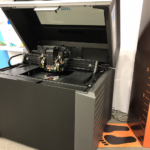

High footfall streets bring shoppers into your store. They browse and try on things, sometimes just for fun. If you had a Desire Engine then your conversion on those things may be higher. But, what if you could manufacture in the store itself? In that way, you would not have to weight eight weeks for your products to arrive from China. You could tell someone to come back in a few hours if an item was out of stock. You could reduce your in-store stock to what you would expect to sell on the day.
This would mean that much less money is tied up in things being shipped. You could instantly respond to trends and the latest fashion. We’re quite a ways off from: it’s going to rain at 15:20 we need to 3D print 87 umbrellas because we will sell those then. We also don’t know what would work with in-store production but there will be products out there that make sense. Surely however you could appreciate the advantages of data-driven stock and manufacturing management that takes into account trends, the day, the weather and other significant variables.
If that’s the case then you may also have noticed that in many retail locations the ground floor is super expensive while successive floors (even in some of the highest footfall areas worldwide) are cheaper. Often in many countries, the first floors and higher are used for some stock and are left empty. Why not put in a knitting machine? An inkjet on textile system would in the center of Paris, right? How about a screen sprint set up? For some products, a laser cutter may make sense.

How about one of those nifty HP sticker printers? Or an inkjet system to make graphics that can be framed? Maybe a tailor in a corner somewhere? How about a shoemaker? Maybe a 3D printer that prints positives that can be turned into silicone molds so that every day you have a different ice cream or cookie shape? An in store 3D scanner and insole production unit? A Formiga P110 maybe would be a bit complex but surely a few Ultimakers or a Fortus would fit into a corner? Or a small team of clothing and shoe customizers that add to existing items? Savile Row has always offered bespoke suits and shoes. It could perhaps become more accessible now through 3D Printing?
I’m not particularly bullish about 3D Printed fashion but the logic of printing in the store with little waste and little C02 in a very responsive way is very strong. Besides clothing, many other custom add ons for existing items can be made to add value. A stamping machine for custom letters or an industrial sewing or embroidery machine to add custom graphics to certain things. Overall however besides the great potential for mass customization and production on the demand, the greatest value will lie in the simple production near the customer in terms of time and physical proximity.
Smart mass customization software such as Twikit could make mass customized parametric parts of a myriad of things available and ensure that they were produced to spec. 3D scanning booths could give stores the perfect sizing information so that clients could find the exact fit of jeans that they need. Right now in store 3D scanning booths seem a bit of an oopsie daisy but only because they only seem to sell figurines. I’ve never wanted a figurine of myself or a loved one, but a perfect fit tennis racket grip, pair of jeans or glasses? Now you have my attention.
The right price, the right part and the right sale could do wonders for this kind of development. High level I’m sure that this is a very fruitful path forward. But, how to explore it? Mass customization at scale should:
- give retailers higher margins
- not give them process/logistical headaches
- not lead to worse products
- lead to better fit (style or physical fit)
- lead to more affect for products
- let the customer feel like the author of the product
- should be better business models eg no stock, the customer pays up front.
- Should not necessarily cost more
- Should be convenient or so annoying as to make sure that the customer is very loyal
- Happen close to the customer
If these things hold true then I think that for a certain family of items in store manufacturing will become a reality. A man making baseball gloves or custom bats in the store is also an event, experience and can draw in people. It marks the retailer as a premium participant in that market and can lead to a continued consumables business that will draw the customer back into the store (time to get some more insoles). Reestablishing a relationship and a pattern of visiting and buying with the customer will establish revenue as well. At the same time, we must be cautious of considering and pitching this just as a gimmick. The product and the value proposition have to be the right. The great thing about 3D printing is that we can quickly test and bring to market lots of products inexpensively giving us a lot of runway to get it right.
If you're looking to get architectural 3D animation in the USA, our service provides an exceptional way to bring your architectural concepts to life through dynamic, immersive visuals. Through our platform, you can easily request high-quality 3D animations that showcase your designs in motion, offering a detailed view of your project from multiple angles and perspectives. Whether it's for a real estate development, a commercial building, or an urban planning project, our expert team ensures that every detail is captured in a visually compelling animation.
Through our website, you can seamlessly get architectural 3D animation tailored to your project’s specific needs. With our help, you can offer potential clients or investors an engaging experience that goes beyond static images. By integrating CGI animations with real-world settings, lighting, and textures, our team creates a lifelike experience that allows your audience to interact with your project as though it were already built. This service is perfect for presenting complex designs in a clear, visually attractive way that stands out in the competitive architectural market.




